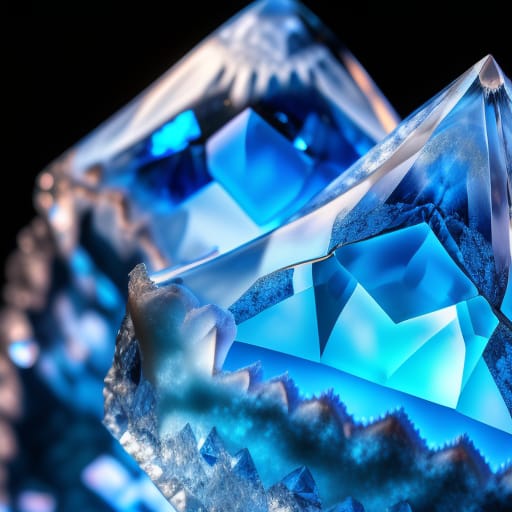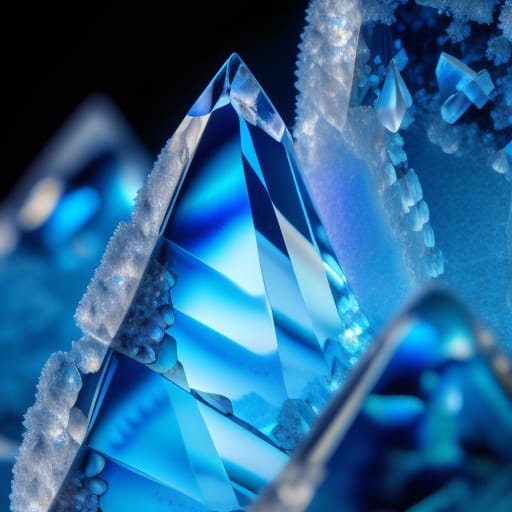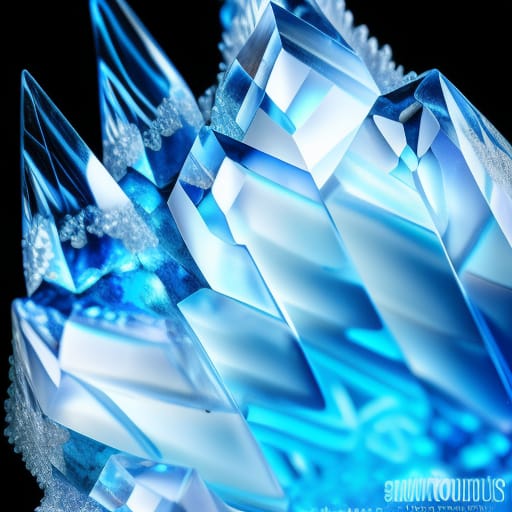Crystals are naturally-occurring geological structures made up of atoms arranged in an orderly, repeating 3D pattern. Growing your own crystals is a fun, educational science project for children and adults alike. The sparkling, faceted crystals you can create are beautiful works of art that make great decorations and gifts.
Typically, borax (sodium tetraborate) is used to grow crystals easily and reliably. However, borax can be tricky to find and some people prefer to avoid this ingredient. Luckily, there are many ways to grow gorgeous crystals without borax!
In this beginner’s guide, you’ll learn:
- The science behind crystal formation and growth
- Multiple methods for growing crystals without borax
- Tips for creating stunning, picture-perfect crystals to delight beginners
- Fun, creative ways to use your homemade crystals for ornaments, decorations, gifts and more!

How Do Crystals Form?
Before we dive into the methods, let’s look at some crystal science basics.
Crystal growth requires:
- Solute particles – the substance you want to grow into a crystal structure
- Solvent – a liquid the solute can dissolve into
- Saturation – adding enough solute to fully saturate the solvent
- Nucleation sites – small areas or particles that seed crystal growth
- Time – crystals take time to form as solvent evaporates
The solute particles arrange themselves into an orderly, repeating pattern as they come out of solution. Given the right conditions, they stack on top of each other, layer by layer, forming the facets and angles characteristic of crystals.
Crystal with six sides
Crystals form with regular, repeating internal structures. Photo by Pixabay from Pexels
Now let’s look at how to create these conditions to grow crystals without borax.
Grow Salt Crystals
Table salt (NaCl) is one of the easiest materials for crystal growing beginners.
Supplies
- Table salt
- Glass jar or drinking glass
- Water
- Pipe cleaner, craft stick, or pencil (optional)
Instructions
- Fill the glass about 1/3 full with warm water.
- Add salt, a spoonful at a time, stirring until no more dissolves. The water should be fully saturated with salt.
- Optional: Tie the pipe cleaner or craft stick to the pencil so it hangs down into the water. This gives the salt crystals something to cling to as they form.
- Let the glass sit undisturbed for 1-2 days. Small salt crystals will begin to form where the pipe cleaner meets the water.
- As the water evaporates over the next week, larger salt crystals will form on the pipe cleaner, craft stick, and along the bottom and sides of the glass.
- To harvest your salt crystals, pour off the remaining saltwater solution. Gently rinse the crystals under cool water to remove excess salt.
Salt crystals growing on a pipe cleaner. Image by Science Sparks
Crystal Growing Tips
- Use warm water to dissolve more salt. Just don’t boil it!
- Add salt slowly to achieve full saturation. Some trial and error is okay.
- Protect the glass from vibrations. Crystals grow best when undisturbed.
- Be patient! Growing large, well-defined crystals can take 1-2 weeks.
Grow Sugar Crystals
Sugar and sugar substitutes also easily form crystals.
Supplies
- Granulated sugar
- Glass jar
- Water
- Pipe cleaner, craft stick or string (optional)
Instructions
- Heat 1 cup of water in the microwave or stovetop until warm but not boiling.
- Stir in sugar, 1 tablespoon at a time, until no more dissolves.
- Optional: Attach the pipe cleaner or string to a pencil resting across the top of the jar so it hangs in the water.
- Let the jar sit for 1 week, undisturbed. Sugar crystals will form on the pipe cleaner or string.
- To harvest, pour off remaining sugar water solution. Rinse the crystals gently under water.
Sugar crystals grown on string. Image by Allison of No Time for Flashcards
Crystal Growing Tips
- Use warm-to-hot water so more sugar dissolves.
- Add sugar slowly until saturated but no more dissolves.
- Cover the jar to slow evaporation for best results.
- Sugar substitutes like citric acid work too!
Grow Alum Crystals
Alum powder contains hydrated aluminum sulfate, which easily forms dazzling crystals.
Supplies
- Alum powder
- Glass jar
- Water
- Pipe cleaner, craft stick or pencil (optional)
Instructions
- Fill the jar halfway with hot water.
- Stir in alum powder a teaspoon at a time until no more dissolves.
- Optional: Attach a pipe cleaner to a suspended pencil.
- Let the jar sit for 1-2 weeks until crystals form on the sides, bottom or pipe cleaner.
- To harvest, pour off remaining liquid. Rinse crystals gently.
Alum crystals grown on a pipe cleaner. Image by Teach Beside Me.
Crystal Growing Tips
- Use hot water to dissolve more alum.
- Be patient – alum crystals take time to form.
- Don’t disturb the jar while crystals are growing.
Create Nucleation Sites
Nucleation sites are areas that “seed” the crystal growth by providing a surface for solute particles to settle out of solution.
Adding a textured surface like a pipe cleaner gives the solute lots of nooks and crannies to settle into as the solvent evaporates. Other nucleation options include:
- Sand or small pebbles
- Seashells
- Marbles
- Craft sticks
- Eggshell fragments
- Leftover crystal pieces
Crystals growing on textured eggshell. Image by Adventures in Science.
Get creative with different materials to see what works best! The more texture, the better.
Controlling Solubility
Solubility refers to how much of a solute will dissolve in a solvent such as water. For crystal growing, you want to achieve saturation – the maximum amount that will dissolve at a given temperature.
Factors affecting solubility:
- Temperature: Heating the solvent increases solubility for most solutes.
- Solute particle size: Finely ground solute dissolves faster.
- Solvent volume: Adding more solvent allows more solute to dissolve.
- Evaporation rate: Slower evaporation means larger crystals can form.
It takes trial and error to find the right balance for each solute. Don’t worry if your first few attempts don’t produce crystals. Keep experimenting!
Understand Molecule Interactions
Solute molecules interact with each other and solvent molecules in specific ways during crystal growth.
Attraction forces impacting crystal formation:
- Ionic bonds – attraction between oppositely charged particles like Na+ and Cl- in salt.
- Covalent bonds – shared electron pairs that link atoms within a molecule.
- Hydrogen bonds – attraction between waters’ hydrogen and solute molecules.
- van der Waals – weak electrical force attracting molecules.
These molecular attractions pull solute particles out of solution together onto nucleation sites in an orderly, repeating pattern, building up faceted crystal layers.
The Role of Evaporation
Evaporation is crucial for crystal formation. As the solvent (usually water) slowly evaporates, it leaves the dissolved particles behind. They cling together at nucleation sites, aligning into crystals.
Evaporation rate affects crystal shape, size, and perfection:
- Fast evaporation grows many tiny crystals.
- Moderate evaporation rate allows large crystals to form.
- Almost no evaporation results in a few giant crystals.
- Too fast evaporation causes irregular, poorly aligned crystals.
Here are some tips for controlling evaporation:
- Cover the container loosely to slow evaporation.
- Use a shallow pan to speed up evaporation.
- Adjust temperature – heat speeds evaporation, cool slows it down.
- Adjust air circulation over the crystal growth setup.
Add Seed Crystals
Seed crystals provide ready-made nucleation sites for crystal growth. To make seed crystals:
- Make a super saturated solution with excess undissolved solute.
- Allow small crystals to form for 1-2 days. These are your seeds.
- Remove the seed crystals and set aside.
- Create a fresh saturated solution and suspend the seed crystals in it.
- Further crystal growth will radiate outward from the seed crystals.
This two-step method helps grow large, beautifully shaped single crystals from the original seeds.
Alum crystals grown using a seed crystal. Image by Teach Beside Me.
Alternatives to Borax
While not strictly required, borax speeds up crystal growth and helps produce impressively large, well-faceted crystals. However, perfectly stunning crystals will form without borax. Simply have patience and experiment.
Safe borax substitutes include:
- Baking soda
- Potassium alum (available online)
- Cream of tartar
- Citric acid
- Vinegar
- Cornstarch
- Epsom salts
Use Textured Surfaces
Adding unique textured surfaces promotes exciting crystal shapes and cluster formations. Try these ideas:
Natural
- Sea shells
- Rocks
- Sand
- Eggshells
- Twigs
Household Items
- Marbles
- Buttons
- Beads
- Sequins
- Lego bricks
Craft Supplies
- Feathers
- Silk flowers
- Glitter
- Pom poms
- Felt
Get creative! Texture provides more surface area for varied crystal growth.
Crystal geode formation using a textured surface. Image by Art is Fun.

Crystal Science Projects
Growing crystals makes an excellent science experiment or project. Follow the scientific method:
- Question – How does ______ affect crystal growth?
- Hypothesis – If I do _______, then _______ will happen.
- Experiment – Systematically change one variable at a time while controlling all other conditions. Take photos at set intervals to compare results.
- Analysis – Organize observations and measurements into tables or graphs. Did crystals form as expected? Why or why not?
- Conclusion – Was your hypothesis correct based on the experimental results and analysis? Suggest improvements for next time.
Science project ideas:
- Vary supersaturation levels
- Test different nucleation materials
- Experiment with evaporation rates
- Observe effect of temperature
- Try growing two solutes together
Learning science through hands-on crystal growing experiments is fun and educational for all ages.
Educational Value
In addition to science, crystal growing allows opportunities to explore:
- Chemistry – solutions, saturation, molecules, polarity, crystallization
- Physics – intermolecular forces, thermodynamics, optics, light refraction
- Math – geometry, symmetry, angles, facets, measurement, graphing data
- Art – color, visual patterns, 3D shapes, creative displays
Discussing these topics while growing crystals engages students’ curiosity and deepens the learning experience.
Add Beauty and Fun
The dazzling colors and magical geometric shapes of crystals inherently create joy and wonder. Enhance the beauty and fun with:
Colorful solutions
- Add food coloring or liquid watercolors
- Try colored sugar or Koolaid
- Dissolvescraps of crayon shavings
- Layer different colored solutions
Fun shapes
- Grow on funky textured surfaces
- Suspend unusual found objects like keys or jewelry
- Shape pipe cleaner into letters or images
Unique containers
- Recycle glassware, jars, and bottles
- Use candle holders or decorative bowls
- Tint or etch glass for added interest
Create Crystal Ornaments
Your homemade crystals can become stunning ornaments and sun catchers.
Ideas:
- Suspend pipe cleaner shapes from fishing line inside glass ornaments
- Attach crystals to Christmas tree ornaments with wire
- Glue crystals into clear glass bulb ornaments
- Use metallic wire to shape crystals into stars and snowflakes
- Attach crystals to chandelier prisms or window hangings
Let your creativity sparkle! Craft gorgeous ornaments everyone will admire.
Crystal ornaments made with pipe cleaners. Image by Left Brain Craft Brain.

Create Holiday Decor
Crystals add magical accents to holiday decor:
Winter
- Snowflake crystals on windows
- Icicle crystals on menororahs
- Crystal pine cones and trees
Valentine’s Day
- Heart-shaped crystal candle holders
- Rose crystal floral arrangements
Easter
- Pastel crystal eggs in wreaths
- Bunny and chick crystals
4th of July
- Red, white and blue crystals fireworks
- Star-spangled crystal wreaths
Halloween
- Crystal balls for fortune telling
- Spiderweb crystals catching light
Let your creativity shine all season long with dazzling crystals!
Conclusion
As you can see, growing gorgeous crystals without borax is totally doable for beginners. With a few basic supplies and safety precautions, crystal growing allows for endless experimentation and creativity.
The magic of crystals arises from chemistry and physics, but the real reward is joy. The pride in growing your own beautiful crystals is matched only by the delight of sharing them as gifts and decorations.
I hope you’ve been inspired to try your hand at this rewarding science art project. May your crystals fill your life with wonder and positivity!
FAQs
What are the best materials to use for crystal nucleation sites?
The best nucleation materials provide plenty of nooks, crannies, and textured surfaces for crystals to form on. Good options include pipe cleaners, sticks, eggshells, sand, sea shells, and marbles. The more texture, the better!
How can I speed up crystal growth?
Use hot water and maximize solubility to achieve full saturation faster. Grow crystals in a shallow pan for quick evaporation. Use seed crystals to give crystals a head start on growth. Adding borax can accelerate crystal formation, but isn’t required. With patience, you’ll get stunning results without it!
What are fun ways to display my crystals?
Show off your crystals’ natural beauty by backlighting them or hanging them in sun catchers. Use them to make ornaments, decorations, centerpieces, night lights, garden accents, and more. Give crystals as gifts on holidays and special occasions. Let your creativity sparkle!
How can I turn crystal growing into an educational science project?
Follow the scientific method: ask a question, make a hypothesis, test variables with experiments, analyze results, and reach a conclusion. Vary conditions like temperature or saturation levels and observe effects on crystal size, shape, purity, and growth rate. Graphing and photographing results makes a great science project.
Is it safe to grow crystals with children?
Yes, with some precautions. Always supervise children and explain safety measures. Avoid high heat. Use mild, non-toxic solutes like sugar or salt. Borax can irritate eyes and skin – gloves and eye protection are recommended. Have kids help make supersaturated solutions but let adults pour hot liquids. Growing crystals teaches science hands-on in a safe, fun way!